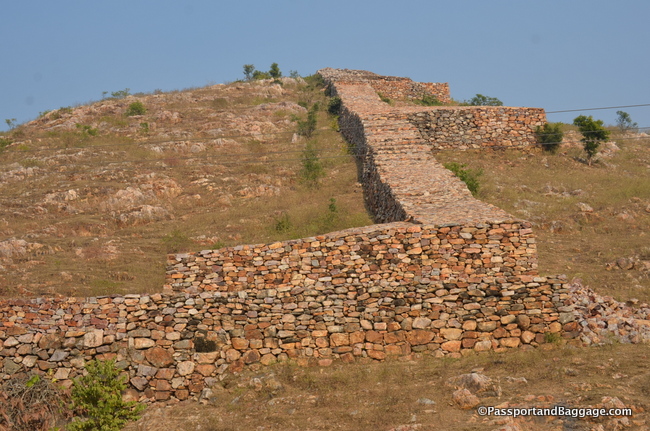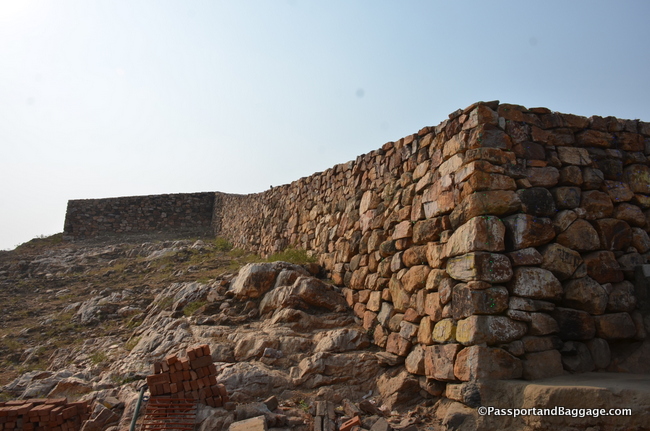November 21 and 22, 2018
Kasaria
Kesaria is a Buddhist stupa first constructed around the 3rd century BCE. The stupa has a circumference of almost 400 feet making it the largest stupa in the world, it then rises to a height of about 104 feet.
The stupa was not discovered until 1958 during an excavation led by archaeologist KK Muhammed, Regional Director of the Archaeological Survey of India.
It is thought that the original stupa probably dates to the time of Ashoka (circa 250 BCE), as the remains of the capital of an Ashokan Pillar was also discovered at the site.
It is thought the stupa was built to honor the site where Lord Buddha must have spent the last days of his journey while preparing to attain Nirvana.

Despite being a popular tourist attraction, Kesariya is yet to be developed and a large part of the stupa still remains covered in vegetation.
As per legends, the Buddha left Vaishali for Kushinagar in the last year of His life. As he walked, the people of Vaishali, a clan called the Licchivis, joined him, then they refused to let him go on his way alone. It is said that here, Buddha gave the Licchivis his begging bowl. The stupa is therefore said to have been built by the Licchivis to venerate the end life of Lord Buddha. At first, it was a mud stupa and the present brick structure is believed to date back to somewhere between 200 AD and 750 AD.
The location of the begging bowl is still a question. Despite many people thinking that it is here, the written diaries of Xuanzang say it is not. However, where it actually is conjecture. It is said to be in Afghanistan, but…

A large number of statues sit in niches around the stupa. Unfortunately, some parts of the statues have not survived the passage of the time or the attacks led by various invading Muslim rulers in the Middle Ages.

Around parts of the stupa modern bricks have been placed to protect the original bricks of the stupa from falling away. As you can see by the photograph they do not go all the way around.
The government is beginning to take care of this site, and excavation of the wooded area is scheduled for 2019. They have built a fence around the property and manning it with guards like this man and his amazing mustache.
Rajapinda
Asura
Jethian Valley, Bihar
Known today as Rajapinda its historic name is Asura.
Xuanzang (602 – 664) a Chinese Buddhist monk, scholar, traveler, and translator who traveled to India in the seventh century described in his travel diaries a large cave on the hill where the Buddha had discourse with Asura. An asura in Buddhism is a demigod or titan of the Kāmadhātu, (desire realm). They are described as having three heads with three faces each and either four or six arms.
The cave sits in the Jethian Valley where King Bimbisara of Magadha received the Buddha after the Buddha’s enlightenment.
Bimbisara (c. 558 – c. 491 BCE) is known for his cultural achievements and was a great friend and protector of the Buddha. Bimbisar, according to Xuanzang, also built the city of Rajgir (others attribute the city’s foundation to his successor).
The cave was first identified by Sir Aurel Stein in 1902 (Dates vary). Stein was a Hungarian-born British archaeologist, primarily known for his explorations and archaeological discoveries in Central Asia.
His collection of books and manuscripts are important for the study of the history of Central Asia and the art and literature of Buddhism.
According to the Bihar State Educational Infrastructure Development Corporation
“In 1899, Sir Auriel (sic) Stein identified the Rajapinda Cave on the eastern hill with Asura’s Cave. Sir Stein reported a 6 to 12 feet wide road around 500 meters long leading to the cave as mentioned by Venerable Xuanzang. Sir Stein also mentioned in his report a big stone platform and a massive wall (measuring 16 ft wide and 18ft high) leading to the 25 ft high by 20 ft wide by 91 ft deep cave (AsuraCave).”
The view down to the valley though is stunning, sadly the pollution of India keeps the view from being clear.
This is such a remote location and visitors so rare that small crowds began to collect.
These boys gathered at the top of the mountain we gave them the food we had left over from our lunch and then Deepak taught them “Buddham Sharanam Gachchami” which means “I take refuge in Buddha”. It is a chant you hear emanating from Buddhist Temples everywhere.

When we got back down to the bottom of the mountain even more villagers had gathered to wonder about us.
This little girl stole my heart with her smile, which I had to work hard to coax out of her.
Cyclopean Wall
The Cyclopean Wall, while not a Buddhist site per se would have stood during his time.
The name comes from the Greek Cyclopes, the mythical man who had the strength to move builders up hills to build the walls of Mycenae and Tyrins. Greece is the only place in the world that still has an existing Cyclopean Wall, and for this reason, the state of Bihar is trying to get the wall declared a World Heritage Site.
The wall was built of massive undressed stones, of quartzite and phyllite slabs, and without mortar. The remains of the Cyclopean wall suggests that it was around 25 miles long and encircled Rajgir. It was built to provide protection to the ancient settlement. It dates back to the pre-Mauryan era, before 3rd century BCE.
There are many sites that do not show up on the regular Buddhist trails. I have had the pleasure of getting to know Deepak Anand, who is making it his life’s mission to raise awareness of these sites and to preserve them. He has a long road ahead of him.














